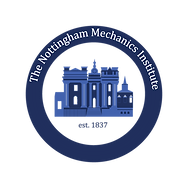About Us - Our History

Opening Hours:
Monday - Friday
9am - 5pm
Saturday & Sunday
CLOSED

The world’s first mechanics’ institute was established in Edinburgh, Scotland, in October 1821 as the School of Arts of Edinburgh (later Heriot-Watt University), with the provision of technical education for working people and professionals. Its purpose was to “address societal needs by incorporating fundamental scientific thinking and research into engineering solutions”. The school revolutionised access to education in science and technology for ordinary people By George Birkbeck .
Around the beginning of the British industrial revolution, he saw the need to educate artisans and mechanics, and these establishments rapidly became meeting places and centres for social activity in many towns and cities.
Our History
In 1837, John Smith Wright of the Nottingham banking family, decided to form the Mechanics’ Institute, modelled on the institutes which were becoming commonplace in other locations in the country.
In October 1837 a meeting was held in the Town Hall at Weekday Cross[1] at which 490 supporters put their names towards the scheme.
The Institute rented premises at 17 St. James’s Street from 1837 to 1845. The committee appointed John Porchett as the Librarian at a yearly salary of 12 guineas (equivalent to £1,153 in 2019). One of the first attractions of membership was free admission to body dissections at Nottingham General Hospital.
In 1840, the Institution held the first ever art exhibition in Nottingham which in just 5 months attracted 224,000 visitors. The receipts from admission charges was £2,996 (equivalent to £272,507 in 2019).
Move to Milton Street
On 28 January 1845, the Institution opened its own Mechanics’ Hall on Milton Street. The architects of the building were Robert Jalland[2] and Thomas Hawksley of Middle Pavement.[3] By this stage the library of the Institution contained some 40,000 volumes.
Charles Dickens appeared at the Mechanics’ Institute on 21 October 1858 and read his Christmas Carol.[4]
Fire of 1867
A fire on 14 March 1867 caused much damage, including the loss of the organ which had been installed in 1847. The Institute claimed £3,950 (equivalent to £352,333 in 2019) on the insurance. £2,200 (equivalent to £196,236 in 2019) was paid off the mortgage on the building, and a public appeal raised £2,579 (equivalent to £230,042 in 2019).
New Building of 1869
A new hall with double the seating capacity of the old hall was designed by Thomas Simpson and opened on 19 January 1869. The new hall was 110 ft long (34 m), 59 ft wide (18 m) and 40 ft high (12 m). It had a floor-space of 8,400 square feet (780 m2). It was lit by five clusters of 81 gas jets.
Famous people who came to speak or perform at the Mechanics include: from Literature: Charles Dickens (3 times), Oscar Wilde (twice), Anthony Trollope, Jerome K Jerome, Wilkie Collins, GK Chesterton and Sir Arthur Conan Doyle. Explorers: HM Stanley, Captain Scott, Sir Ernest Shackleton and Edward Whymper (1st man to climb the Matterhorn). From the theatre and silver screen: Dame Anna Neagle. Entertainment was provided by Madame Tussaud and her Waxworks, Tom Thumb and the operatic diva Jenny Lind. Whilst from Egyptology came Sir Flinders Petrie and Arthur Weigall (speaking on “Excavating at Luxor” in 1924).
In 1912 the adjacent Mansfield Road Baptist Church was purchased and converted into a lecture hall.
Birkbeck House 1964
In 1964 the Mechanics’ Institution decided to redevelop the building on the same site. The stone façade of the 1845 building was exported by an American and re-erected as his Californian hunting lodge.
The new building was called Birkbeck House and cost around £750,000 (equivalent to £15,310,455 in 2019). The Mechanics’ used the first floor and rented out the rest of the building to tenants.
At the opening in April 1966 the Mechanics was described thus: “It has survived because it has adapted itself to changing circumstances in this modern age and has at the same time preserved all the best traditions of the past”.
Facilities provided included: the Members’ Lounge, Restaurant, Buttery (Members’ Bar), Library & Quiet Room, Billiard Room, Card Room, Chess Room and Activities Room.
Birkbeck House was demolished in July 2005, and redeveloped for retail and student accommodation.
FAST FORWARD TO TODAY
In 2003, the Mechanics’ Institute moved again to a new home on North Sherwood Street where we are today we still host many adult learning classes and also we are used by groups such as the Dickens Society and The Civic Society
The Pipe Organ
A specification of the pipe organ, built by Henry Bevington, can be found on the National Pipe Organ Register.



